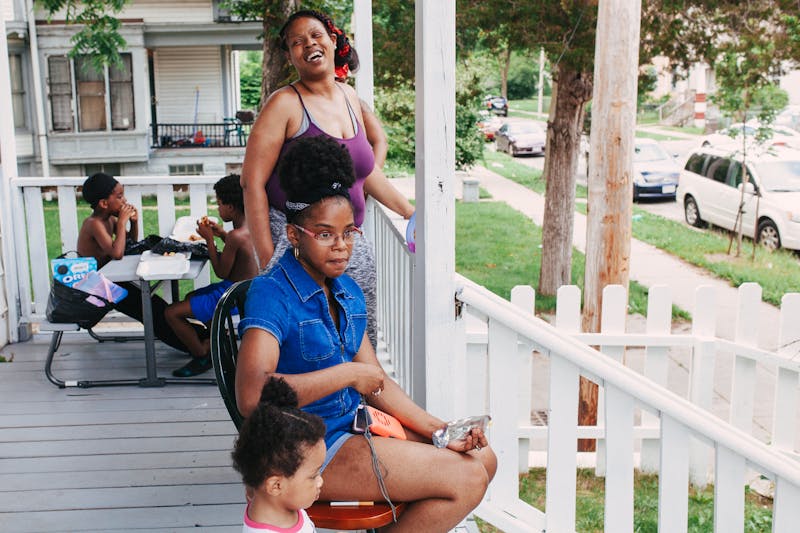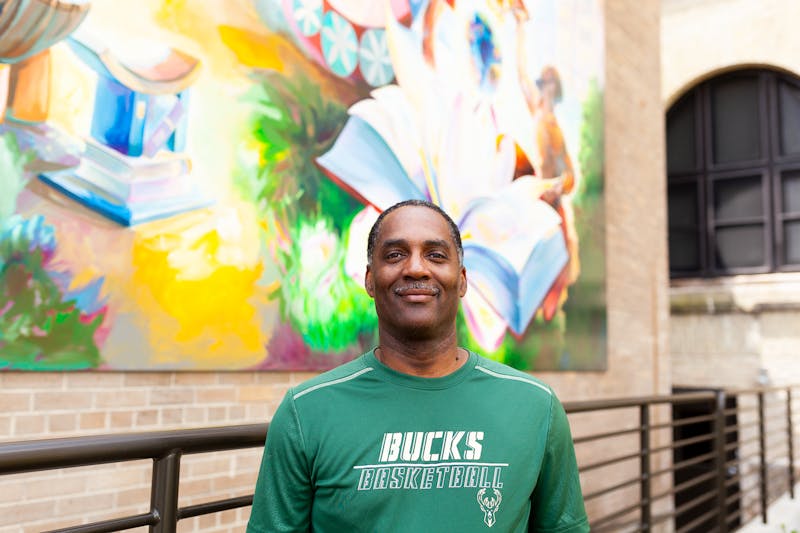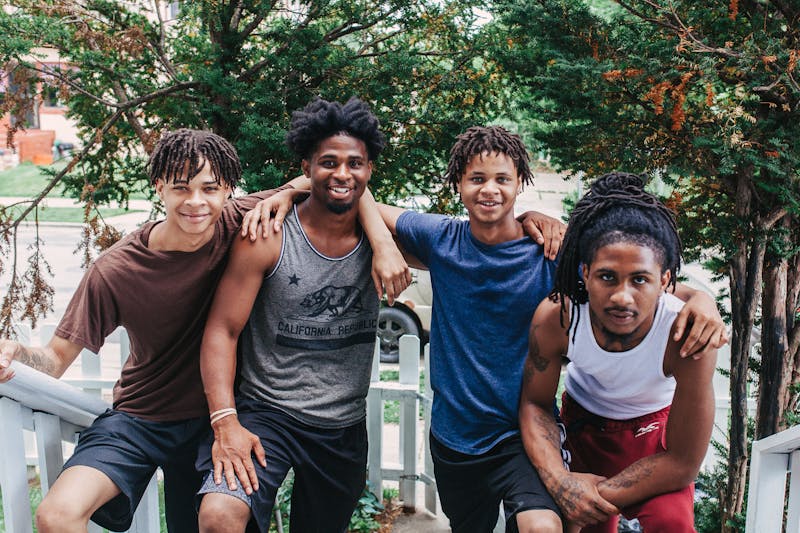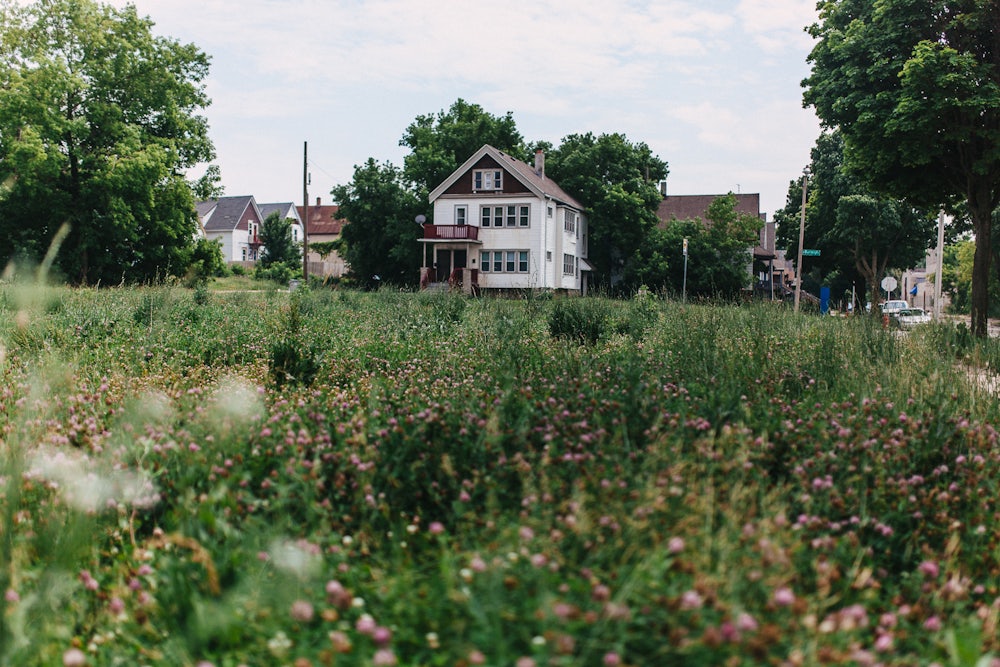Keisha
Robinson’s family came to Milwaukee from Chicago in the 1980s because, as
Robinson put it, “Chicago was getting out of pocket.” With crime rising and jobs
disappearing in the Windy City, she told me, “my mom wanted a better place for
us to live.” But Robinson’s mother could never have anticipated the crucibles
awaiting her daughter in Wisconsin—the array of social and political deficits
associated with the five numbers that came at the end of her listed address: 53206,
now notoriously known as the most incarcerated zip code in the country.
The neighborhood’s rectangular outline sits like a brick just north of the Fiserv Forum, home of the NBA’s Milwaukee Bucks in downtown Milwaukee, where the 2020 Democratic National Convention will be held next summer. In addition to its high incarceration rates, 53206, a heavily African American district, suffers from every manner of social ill, from socioeconomic stagnation to poor health. The Democratic primary field is teeming with proposals to address these ingrained injustices, and the party’s eventual candidate will also have a personal incentive to pay attention to what is happening in 53206: Its residents, among others in Milwaukee, may well prove to be the key to Democrats’ hopes of winning the battleground state of Wisconsin and unseating Donald Trump in the presidential election.
As long as those residents can gain access to the ballot, that is.
African Americans represent nearly 40 percent of Milwaukee’s population, but their political clout has been diminished by laws that suppress the black vote. There is also the problem of African Americans choosing not to vote: Black turnout in Wisconsin dropped nearly 19 percent between the 2012 to the 2016 elections—a clear sign that, despite their historic need to mobilize black voters, Democrats haven’t been meeting the challenge especially well of late.
Robinson, 42, is one of the city’s most engaged community activists, fighting to ensure that voters in 53206 will be able to have full and free ballot access in 2020. In the run-up to the election, she will be knocking on doors, attending community meetings, and vying to bring resources and hope to a neighborhood that hasn’t had much of either in recent years. The area’s woes can be traced back to its federal classification as a “Negro and Slum Area” some 80 years ago—part of the practice of “redlining” African American districts across urban areas in the North in order to deny their residents access to home loans.

But many of 53206’s
troubles are of a more recent vintage. A cratered industrial economic base; a
tough-on-crime judicial system that preys on black citizens; and, now, a
concerted effort by lawmakers to deprive those citizens of the vote—all have
contributed to the longstanding sense that 53206’s uphill challenges may be too
steep to surmount. Or to put it a different way: These conditions have
contributed to a pervasive myth that places like 53206 are beyond any genuine rehabilitation—that
they are, as the federal government once deemed them, too negro and too slum to
be saved.
No aspect of that myth is more damaging than 53206’s claim to infamy: that it is the nation’s most incarcerated plot of land. Who would establish a long-term political organizing effort in such a community? How many businesses will go on writing off this zip code as a crime-ridden wasteland, unworthy of investment? Even though this damaging image is something of a fiction, its stubborn endurance shows that lifting up places like 53206 will require more than policy proposals to reform the criminal justice system or raise the minimum wage. It will mean that we set about dismantling all the myths that have kept places like 53206 down.
Like other Northern cities that hosted a major influx of African Americans fleeing from the South during the Great Migration and onward, Milwaukee did not exactly turn out to be the promised land. Redlining—the racist classification of many black-majority neighborhoods as unsound investments on the basis of what was euphemistically termed “residential security”—was one reason. Analysts had long categorized 53206 as the major part of a “D5” district—i.e., a high-risk area. Its residents were deemed “laborers” and “ne’er-do-wells.” On a practical level, this meant that the ability to get a home loan in 53206 was more fiction than fact, at least in the decades between the creation of the Federal Housing Administration in 1934 and Congress’s ratification of the Fair Housing Act in 1968. As Reggie Jackson, the head griot of America’s Black Holocaust Museum in Milwaukee, told me, “Redlining prevented people from gaining generational wealth which would allow them upgrade their house and move to a bigger house.”
On another, less tangible level, redlining is how the myth of 53206’s inherent criminality began.
As if redlining were not enough, Milwaukee’s surrounding counties implemented restrictive covenants preventing black tenants equal access to the housing market. This practice confined most blacks to the northwestern portion of the city, where 53206 lies. While the Supreme Court ruled such covenants to be unconstitutional in 1948, they remained on the books until Congress passed the Fair Housing Act.
And the legacy of the covenants, along with redlining, continued well into the twenty-first century. According to a 2016 report, in Milwaukee “whites represent 70 percent of the population, yet received 81 percent of the loans. African Americans are 16 percent of the population yet only received 4 percent of the loans.” In 2010, a sign that read “nigger lover” was placed in the yard of a mayor in a 95 percent white county after he approved a 180-unit public housing project there, according to a housing complaint filed by the U.S. Department of Justice. And the city’s segregation is stark: To this day, black people, for the most part, live on Milwaukee’s north side, while whites live on the south side.

For all those government-ordained hardships, Jackson’s family moved from Mississippi to Milwaukee in 1973 because of the city’s job opportunities. “43 percent of blacks in the city of Milwaukee in 1970 worked in industrial jobs,” Jackson, wearing a green Milwaukee Bucks shirt, told me earlier this year as we stood on the border of 53206. “That was the highest rate of any city in the country, even higher than Detroit.” Thanks to these industrial jobs, the median income for Milwaukee’s black population was the seventh-highest in the country. In 1970, the portion of black people living in poverty in the United States was 35 percent. In Milwaukee, it was significantly lower, at 27 percent.
But by the time Jackson’s family arrived, the implosion of Milwaukee’s economy had already begun. “From 1963 to 2015, the city of Milwaukee lost 91,000 manufacturing jobs,” Jackson told me. As Alec MacGillis reported in his 2014 article in The New Republic about former Wisconsin Governor Scott Walker, “Not long after a substantial African American community took shape, Milwaukee’s industrial base began to collapse and its manufacturing jobs disappeared. This left almost no time for the city to develop a black middle class or a leadership elite. Within short order, Milwaukee had some of the most glaring racial disparities in the country.”
As recently as 2018, Milwaukee ranked second in USA Today’s “15 worst cities for black Americans,” primarily because the median income of black families is 42.5 percent of white families. The black unemployment rate is roughly four times that of white unemployment. Home ownership among black Milwaukeeans stands at 28.2 percent, while white Milwaukeeans enjoy a home ownership rate of 69.5 percent.
Much of Milwaukee’s formerly robust workforce was employed at factories along Milwaukee Road, a train line that carried goods to the factories alongside it. Allis-Chalmers employed 11,500 people; American Motors, 4,000; Schlitz Brewing, 2,800; Pabst Brewing, 2,600. Meanwhile, “dozens and dozens and dozens of businesses grew up along the rail line,” according to Jackson, to serve the factories’ workers. The 30th Street Corridor, which now sits squarely in 53206, was once home to “a lot of small factories.”
That same corridor now looks like a “bomb hit” it, Jackson says. Perhaps the largest anchor employer in this area was the manufacturer AO Smith, hiring nearly 8,000 people on its own. The company was once the largest car frame manufacturer in the United States, servicing frames for the majority of American-made cars and trucks. Its buildings occupied the 30th Street Corridor, which is now “really one of the most difficult areas in Milwaukee,” Jackson, who grew up in the area, says. “Drive down 30th Street, you will see a trail—a trail of destruction.” It is indeed a sobering sight: hollowed-out buildings, abandoned train tracks. I was twice warned that, even as a large black man, that “you might not want to be here.”
Khalif Rainey, an alderman on the Milwaukee Common Council who represents parts of 53206, told me that the district is distressed “due to these losses in job opportunities.” By 2004, AO Smith employed only 575 people. During its industrial heyday, the ten largest employers in Milwaukee were either in manufacturing or brewing, and they offered their often minimally educated workers healthy salaries and benefits; in 2004, the ten biggest employers either paid comparatively low wages (like the grocery store chain Roundy’s and the retailer Kohl’s), or had higher barriers of entry, via job requirements of advanced degrees or long periods of intensive, expensive training.
This lack of economic opportunity is borne out in the data. Marc Levine, founder and director of the University of Wisconsin-Milwaukee’s Center for Economic Development, has shown that black males born in 53206 into households in the 25th percentile of the national income distribution in the late 1970s and early 1980s remained in the twenty-fifth percentile in adulthood (over the years 2014-15). By contrast, white males in Milwaukee born into the same twenty-fifth percentile some 30 years ago rose to the forty-fifth percentile by adulthood. Between 2013 and 2017, only 46 percent of adults in 53206 held full-times jobs, compared to 75 percent in Milwaukee’s suburbs and 69 percent in the city of Milwaukee.
The deteriorating economic outlook in 53206 coincided in the 1990s with new tough-on-crime policies enacted at the state and federal levels—a devastating mix. When a 13-year-old Keisha Robinson arrived at 19th and Vine in 1986, just outside the 53206 zip code, she remembered Milwaukee as “a cool town.” She told me, “It wasn’t as bad here as it is now or as Chicago then.” But that began to change in the 1990s. “You just started seeing police everywhere,” she said. “People just started getting locked up.”
She said the police targeted groups of black men. “Officers would walk up and start asking questions, engaging them,” she said, “and then next thing you know it becomes negative. The questioning would become searching and then they’d take them to jail.”
Wisconsin’s crackdown on urban crime led to drastic increases in its prison population. By the 2000s, over half of the black men in Milwaukee County in their thirties had state prison records. Combined with mandatory-minimum sentencing, the three strikes rule, and other punitive measures, the carceral state became an outsized presence in this small neighborhood.
Robinson’s first run-in with the law, in 1996, came when she was 19, by way of a relative. “He would get credit cards, and we would go to the store where we got a couple things” with the cards, she explained. “So, I got a felony for that.” The charge made her life prospects diminish starkly. “Employers would run background checks heavily and I’d check a box to show that I committed a crime,” she said. She finally landed a job at a local nursing home—until things took another devastating twist in 1997. “I was about five months pregnant and I remember going to my boss to tell her I’d need time off,” she said. “And I lost that job.”
That blow triggered “a lot of homelessness,” “a lot of not being able to provide for [her] kids,” and “a lot of not being able to have clothing and be able to afford bills,” she said. In 2004, Robinson left some of her younger kids at home under her 14-year-old niece’s care. While she shopped for those children, the police paid her home a visit. They said she was guilty of child neglect—another run-in with the law that produced six misdemeanor counts and court-ordered supervision. About two years later, the police raided her home because her then-boyfriend was suspected of selling drugs. When the police found two bags of her boyfriend’s weed, they charged her as well. With this newest charge, Robinson’s supervision was revoked. So instead of probation for those six misdemeanor counts, she faced 36 months in jail—six months for each of those misdemeanors.
In Wisconsin, probation is a pervasive ill. The average length of parole supervision there stands at nearly two times higher than the rest of the nation, according to a report by Columbia University’s Justice Lab. The same report found that over half of the state’s total 2017 prison population had been, at some point, under supervision or probation, and that those on parole or probation have to adhere to standards and requirements that are “numerous, onerous, confusing, and void of public safety justifications.” Revocation of parole is also fairly common, especially if you’re black. Reporting has found that the confusing requirements of parole, as well as longer parole times, increase “the likelihood an offender will be re-incarcerated for technical violations that do not involve criminal behavior.”
This is not an accident. Former Governor Scott Walker, as a member of the Wisconsin State Assembly, coauthored so-called truth-in-sentencing legislation in 1997 that aimed to limit the use of parole in favor of prison time. (Walker credited the Koch-funded America Legislative Exchange Council for supplying the language for the measure.) The prison population and those under supervision increased significantly following passage of the legislation, which ended parole opportunities for many categories of prisoners. The bill was particularly vicious in several respects: It made nonviolent property-crime and drug offenders “serve 100 percent of their prison time, eliminated the use of parole boards for people incarcerated after the year 2000, and provided no mechanism to keep judges’ sentences within any standardized ranges,” according to an in-depth 2016 report by City Lab.
The extensive incarceration of 53206’s residents has attracted a slew of tabloid-style media attention. The neighborhood has made headlines for being “the most incarcerated zip code in the nation,” as the documentary Milwaukee 53206 breathlessly reported. A BBC2 documentary titled Murder in Milwaukee also played up the same sensational statistic. But numerous studies have shown that this eye-opening statistic is a fiction. A 2013 study by the University of Wisconsin-Milwaukee found that Wisconsin had the highest incarceration rate for black men. Deeper in the study, researchers showed that a plurality of those incarcerated black men came from 53206. An indelicate conflation of these two statistics led to 53206’s dubious claim to fame.
Levine’s Center for Economic Development issued a report in 2019 demonstrating that 53206, calculated numerous ways, could never be considered the most incarcerated in the country. According to the report, tracked by childhood zip code for people born in the early 1980s and incarcerated by 2012, 53206 would be listed 7 percent less than the nation’s highest by that measure, Nashville’s 37208.

Some might argue that the distinction doesn’t matter much. And surely 53206 suffers from a host of serious problems, including a very high incarceration rate. But 53206 stands as an extreme example of how a reputation for ingrained criminality can amplify a neighborhood’s ills, in a poisonous kind of negative feedback loop. It’s easier to criminalize black people and say they are prone to certain pathological tendencies when they are hyper-concentrated in one area. The scholars Barbara and Karen Fields called this “racecraft”—the idea that differences between races are rooted in “the eugenicist, biological racist notion that something—whether it is blood or genes—has created a set of scientifically distinct groupings of people.” In Milwaukee broadly and 53206 specifically, the task of racecraft is made easier, with black people relegated, both formally and informally, to certain areas that are considered godforsaken slums.
What is to be done? The cruelest twist for the residents of 53206 is that they have been actively disempowered to fight back, even while they are maligned as ne’er-do-wells and criminals. In Wisconsin, no one in prison can cast a ballot. And thanks to Scott Walker’s truth-in-sentencing law, neither can those felons who are under supervision. In 2007, 1,215 black men in 53206 alone were under supervision, which means that not one of them could cast a ballot even though they have “paid their debts to society.”
Furthermore, every two years, the Wisconsin Election Commission runs checks to deactivate the registration of anyone who hasn’t voted in four years. With longer prison sentences, there is a greater chance a felon’s registration will be deemed ineligible.
Robinson is deeply familiar with the many ways the state can take away a person’s vote. After she served her time for the child neglect charges, Robinson ran into trouble again in 2015. Her then-fiancé purchased a gun to protect him and his family amidst a neighborhood shooting spree. Soon after, the police raided her home yet again, claiming, as Robinson remembers it, that “her children had to have been involved in the shootings around the community.” When they found the gun, they slapped her and her fiancé with a felony charge for possession of a firearm. With that charge, she was sent back to jail for two years, and she was placed under supervision when she got out in 2017.
The incarceration problem in 53206 also exacerbates a voter ID problem. Many residents are unable to vote because they don’t have proper state-issued identification, like a driver’s license. In 2011, then-Governor Scott Walker signed Wisconsin Act 23 into law, requiring that voters present approved photo ID to cast a ballot. In Wisconsin, 55 percent of black men and 49 percent of black women do not have a valid driver’s license. And a 2007 study by the Employment and Training Institute at the University of Wisconsin-Milwaukee showed that only 4 percent of the formerly incarcerated in 53206 have valid driver’s licenses, often because of failure (or inability) to pay for municipal and misdemeanor citations and court costs.
Two years ago, Robinson decided she had had enough. She began to ask herself, “How can I do something different?” She contacted 9 to 5, an organization founded initially to guarantee high-quality working conditions for women in the United States. She began relentlessly volunteering, even through bouts of homelessness, and eventually joined the community outreach team, earning 15 dollars an hour. Robinson worked with the group on a range of women’s health issues as well as an initiative to ban the box, or bar companies from asking job applicants to check a box if they have a criminal record, an issue close to her heart.
When a job at BLOC, an organization that focuses on amplifying the voices of black Milwaukeeans, opened up, Robinson “felt like it was God’s will and I knew I could help more at BLOC.” At age 40, Robinson landed her first salaried job. She was offered $40,000 per year, nearly $20,000 more than her neighbors’ average salary throughout the 53206 zip code.
BLOC employs 23 people, including Robinson and other neighborhood residents, as “civic ambassadors” who knock on doors to enlist residents to vote and get politically involved. BLOC boasts that it is “the only organization organizing off cycle,” according to founder Angela Lang, meaning that it’s driven by a long-term commitment to political and electoral reform, not just winning the next election. “No one has engaged us,” Lang told me. “No one has talked to us, and there are obstacles, real challenges about getting to the polls and registering and making sure you have the right I.D. and all of that. And no one was really addressing that [engagement] in a real, genuine way on a year-round basis.”
Even though Robinson can’t vote, she has found a home for her activism in BLOC. While the Democrats convene in the next neighborhood over to designate their 2020 presidential nominee, Robinson and her colleagues will be combating the forces on the ground in 53206 that have consigned them to a new form of redlining and Jim Crow voter restrictions. Her story is not an accident; it came about by design. So the next time Democrats complain about lower voter turnout, not just in 53206, but in any beleaguered neighborhood, they might think first about the policies, both old and new, that have served and continue to serve as stumbling blocks for black political participation. And not only policies, but the myths that help keep those policies in place.
